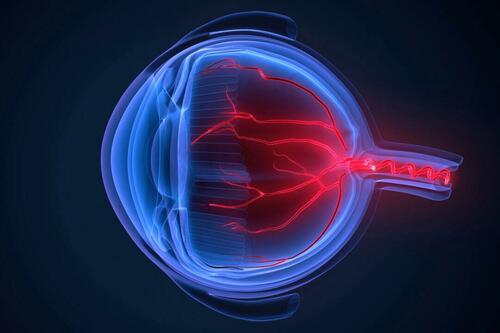
Исследование показало повышенный риск воспалительного расстройства глаз после отпуска COVID-19
Авторизован Меган Редшоу, Дж.Д. через The Epoch Times
Люди с историей увеита могут испытывать рецидив воспалительного расстройства глаз после отпуска COVID-19, особенно в раннем поствакцинальном периоде.
 (MicroScience/Shutterstock)
(MicroScience/Shutterstock)Недавно опубликованное исследование в JAMA Ophthalmology показало, что около 17% из 474 000 вакцинированных людей с историей увеита испытывали рецидив в течение одного года после отпуска.
Увеит — это инфляция внутри глаза, которая возникает, когда иммунная система борется с инфекцией или атакует здоровые ткани в глазах. Это может вызвать симптомы, включая боль, покраснение и судьбу зрения, одновременно разрушая увею и другие части глаза.
Исследователи собрали данные обо всех людях с диагнозом увеит в Южной Корее в период с января 2015 года по февраль 2021 года, чтобы определить риск рецидива после вакцинации COVID-19. Данные были получены из баз данных Корейской национальной службы медицинского страхования и Корейского агентства по контролю и профилактике заболеваний. О происшествии увеита сообщалось с 26 февраля 2021 года по 31 декабря 2022 года. Случаи были классифицированы в соответствии с началом через три месяца, шесть месяцев и один год, тип увеита (передний или непередний) и тип вакцины.
Лица, включенные в исследование, получили по крайней мере одну дозу вакцины против COVID-19 от Pfizer, Moderna, AstraZeneca или Johnson & Johnson и не дали положительный результат на SARS-CoV-2 в течение периода исследования.
Результаты исследования
Из 473 934 человек, включенных в исследование, совокупная заболеваемость поствакцинальным увеитом составляла 8,6 процента в три месяца, 12,5 процента в шесть месяцев и 16,8 процента в один год, в основном внутреннего типа, который влияет на радужную оболочку передних глаз. Кроме того, риск рецидива увеита был самым высоким в первые 30 дней после отпуска, достигал пика между первой и второй дозами вакцины и определялся с помощью субсецентных вакцин.
По словам исследователей, Первая доза вакцины может активировать инфляционные пути, ведущие к начальной инфляции у людей, склонных к аутоиммунным реакциям или имеющих историю увеита.. Тем не менее, существует снижение риска при повторной вакцинации, что может быть связано с адаптацией иммунной системы к антигену вакцины, для подтверждения этой гипотезы необходимы дальнейшие исследования.
Кроме того, риск экспериментировать с состоянием, введенным среди концертов всех четырех типов вакцин, особенно среди тех, кто получил вакцину COVID-19 от Pfizer. Эти пациенты чаще испытывали рецидив увеита в течение раннего периода. Аналогичным образом, те, кто получил Модерну, подвергались более высокому риску возникновения увеита после первого размещения и в течение раннего периода.
Примечательно, что были различия в типах увеита, наблюдаемые в периоды до и после отпуска.. Среди пациентов с инфекционным увеитом до получения вакцины от COVID-19 почти 54 процента имели неинфекционный увеит после вакцинации, в то время как большинство людей с неинфекционным увеитом до вакцинации имели рецидив того же типа после вакцинации.
Большинство пациентов с увеитом были от 60 до 79 лет, а затем в возрасте от 40 до 59 лет. Среди них с сопутствующими заболеваниями, высоким кровяным давлением, диабетом и ревматическими заболеваниями были наиболее распространенными.
«Хотя увеит после вакцинации встречается редко, наши результаты подтверждают повышенный риск после отпуска COVID-19, частично в раннем поствакцинальном периоде», — говорят авторы исследования. «Эти результаты подчеркивают важность зрения и мониторинга увеита в контексте профессий, включая вакансии COVID-19, частично у лиц с историей увеита. "
Другие исследования вакцинно-ассоциированного увеита
Другие исследования обнаружили связь между увеитом и вакцинацией от COVID-19, в том числе исследование, опубликованное в журнале Ophthalmology в феврале 2023 года. Исследование дало представление о возможной временной связи между сообщенными событиями, связанными с вакциной, и вакцинами SARS-CoV-2 от Pfizer, Moderna и Johnson & Johnson.
Кроме того, сообщалось о событиях глазного адреса после занятия COVID-19 в дополнение к увеиту, включая паралич лицевого нерва, сосудистую окклюзию сетчатки, острую макулярную нейроретинопатию, тромбоз и болезнь Грейвса с новым началом.
В статье, опубликованной в июне 2022 года в журнале Vaccines, исследователи проанализировали глазные приключенческие события, сообщенные в систему отчетности о предварительных событиях вакцин (VAERS), чтобы предоставить клиницистам и исследователям широковещательную картину глазных побочных эффектов эпизодов COVID-19.
VAERS - это система добровольной отчетности, поддерживаемая Управлением по контролю за продуктами и лекарствами США и Центрами по контролю и профилактике заболеваний. Он предназначен для обнаружения сигналов безопасности вакцин, хотя, по оценкам, он представляет менее 1% реальных приключенческих событий.
За период анализа с декабря 2020 года по декабрь 2021 года VAERS получила 55 313 отчетов о глазных приключенческих событиях, 6 688 из которых соответствовали критериям включения. Из этих сообщений 2229 были связаны с керлингом век, глазной гиперемией и конъюнктивитом, 1785 были сообщениями о размытом зрении и 1322 были сообщениями о нарушениях зрения.
Женщины составили 74 процента от общего числа сообщений, и заболевания глаз затронули первичных лиц в возрасте от 40 до 59 лет, которые получили либо прививку Johnson & Johnson, либо вакцину Moderna.
Из пациентов, которые сообщили о связанных с глазом композициях, 50 процентов получили вакцину Pfizer от COVID-19, 38 процентов получили Moderna и 12 процентов получили вакцину Johnson & Johnson.
Хотя авторы исследования заявили, что не могут определить, кто был связан с повышенным риском приключенческих событий, их данные предполагают «возможную связь между вакцинами против COVID-19 и событиями увеличения глаз». "
«Врачи приучены не только знать об этой потенциальной проблеме, но и проверять любые основные состояния пациента и тщательно документировать в VAERS в течение нескольких недель после набора», — говорят они.
Согласно текущим данным VAERS, 734 случая увеита, 539 случаев глазной инфляции, 2 781 случай нарушений сетчатки, 11 641 случай отклонений лицевого нерва и 3909 сообщений о свертывании век, глазной гиперемии и конъюнктивите были зарегистрированы после вакцинации COVID-19 в период с 14 декабря 2020 года по 29 марта.
Сообщалось о потенциальных ассоциациях между увеитом и другими профессиями, включая грипп, вирус папилломы человека и вакцины против вируса ветряной оспы. Однако эти исследования не обязательно устанавливают причинно-следственную связь.
Тайлер Дерден
Свадьба, 05/01/2024 - 19:05














